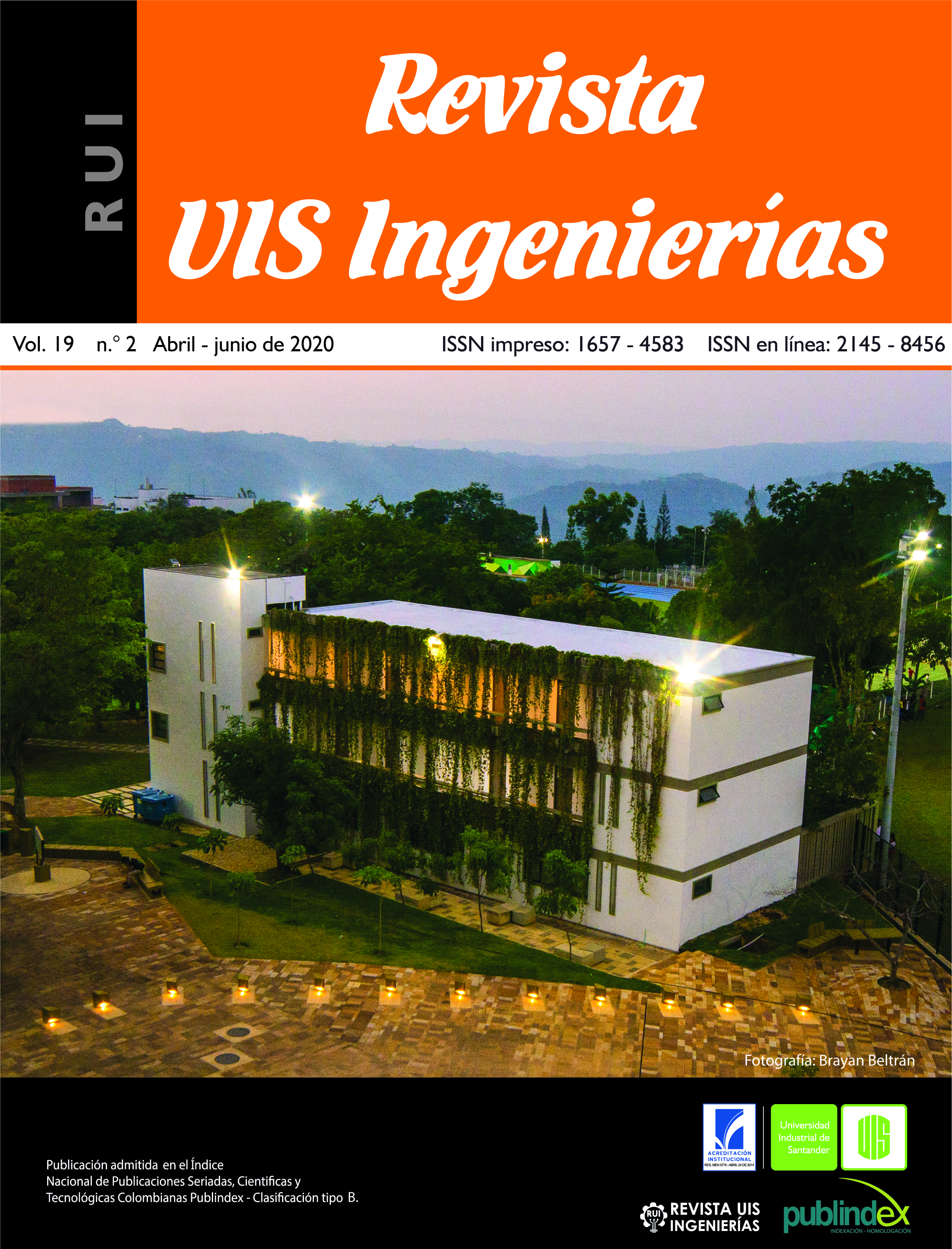Quartz grinding specific rate of breakage (Sj) classification by discriminant analysis
Published 2020-03-25
Keywords
- ball milling,
- discriminant analysis,
- grinding,
- quartz,
- specific rate of breakage
How to Cite
Copyright (c) 2020 Revista UIS Ingenierías

This work is licensed under a Creative Commons Attribution-NoDerivatives 4.0 International License.
Abstract
Specific rate of breakage (Sj) is an important parameter for grinding kinetics behavior due to it is reverse related with the process energy consumption. Size grinding media, viscosity medium, and fine particle formation are some of modifiable variable for to reduce the energy in the grinding process. Nowadays, there is no model that explains the relationship among Sj and parameters described above. A classification model based on linear discriminant analysis for quartz wet grinding was proposed to identify conditions with the high Sj. Three grinding kinetic behavior groups have been found through cluster analysis and two discriminant functions that explicate difference among groups. The first function was the most powerful differentiating dimension with 89.01% of prediction percentage, and the second one represented an additional significant dimension with 10.99% of prediction.
Downloads
References
[2] F. Austin, L.G. Concha, “Diseño y simulación de circuitos de molienda y clasificación,” CYTED, vol. 1, pp. 1–394, 1994.
[3] S. C. Chelgani, M. Parian, P. S. Parapari, Y. Ghorbani, J. Rosenkranz, “A comparative study on the effects of dry and wet grinding on mineral flotation separation–a review,” J. Mater. Res. Technol., vol. 8, no. 5, pp. 5004–5011, 2019, doi: 10.1016/j.jmrt.2019.07.053
[4] N. Kotake, T. Kawaguchi, H. Koizumi, Y. Kanda, “A fundamental study of dry and wet grinding in bending tests on glass - Effect of repeated impact on fracture probability,” Miner. Eng., vol. 17, no. 11–12, pp. 1281–1285, 2004, doi: 10.1016/j.mineng.2004.06.030
[5] D. Feng, C. Aldrich, “A comparison of the flotation of ore from the Merensky Reef after wet and dry grinding,” Int. J. Miner. Process., vol. 60, no. 2, pp. 115–129, 2000, doi: 10.1016/S0301-7516(00)00010-7
[6] F. N. Shi, “Effects of slurry rheology on industrial grinding performance,” vol. 65, pp. 125–140, 2002, doi: 10.1016/S0301-7516(99)00016-2
[7] F. N. Shi, “Estimation of shear rates inside a ball mill,” International Journal of Mineral Processing, vol. 57, no. 3, pp. 167–183, 1999, doi: 10.1016/S0301-7516(99)00016-2
[8] S. Glagolev, 14th International Congress for Applied Mineralogy (ICAM2019) : Belgorod State Technological University named after V. G. Shukhov, 23–27 September 2019, Belgorod, Russia. Cham: Springer, 2019.
[9] M. Y. E.-B., S. H. I. M. Shabaka, M. Abdel Wahab, S. E. E. Hamza, “On rheological behavior of aqueous polyacrylamide solution. Empirical relation of the viscosity as a function of concentration and shear rate,” Int. J. Adv. Res., vol. 1, no. 6, pp. 77–82, 2013.
[10] R. R. Klimpel, “Chemical Additives for Wet Grinding of Minerals,” Powder Technology, vol. 31, pp. 239–253, 1982, doi: 10.1016/0032-5910(82)89012-8
[11] V. K. Gupta, “Determination of the specific breakage rate parameters using the top-size-fraction method : Preparation of the feed charge and design of experiments,” Adv. Powder Technol., vol. 27, no. 4, pp. 1710–1718, 2016, doi: 10.1016/j.apt.2016.06.002
[12] V. K. Gupta, “Effect of size distribution of the particulate material on the speci fi c breakage rate of particles in dry ball milling,” Powder Technol., vol. 305, pp. 714–722, 2017, doi: 10.1016/j.powtec.2016.10.075
[13] A. C. Rencher, "A Review Of Methods of Multivariate Analysis, Second Edition,” IIE Transaction, vol. 37, no. 11. 2005. doi: 10.1080/07408170500232784
[14] L. Kaufman and P. J. Rousseeuw, “Finding Groups in Data: An Introduction to Cluster Analysis,” Biometrics, vol. 47, no. 2, p. 788, 1991, doi: 10.2307/2532178
[15] D. Garson, Discriminant function analysis. USA: Statistical Associates Publishers, 2012.
[16] B. Wills, Will’s Mineral Processing Technology, Eighth vol. 1. Oxford, Reino Unido: Butterworth-Heinemann, 2013.
[17] F. Bond, “Crushing and Grinding,” Br. Chem. Eng., vol. 6, pp. 378–385, 1961.
[18] ASTM, “U.S. and Metric Sieve Sizes - Gilson Co.” [Online]. Available: https://www.globalgilson.com/sieve-sizes
[19] A. Solanas, R. Manolov, D. Leiva, M. M. Richard’s, “Retaining principal components for discrete variables,” Anu. Psicol., vol. 41, no. 1–3, pp. 33–50, 2011.
[20] D. R. Nascimento, B. R. Oliveira, V. G. P. Saide, S. C. Magalhães, C. M. Scheid, L. A. Calçada, “Effects of particle-size distribution and solid additives in the apparent viscosity of drilling fluids,” J. Pet. Sci. Eng., vol. 182, no. July, p. 106275, 2019, doi: 10.1016/j.petrol.2019.10627

